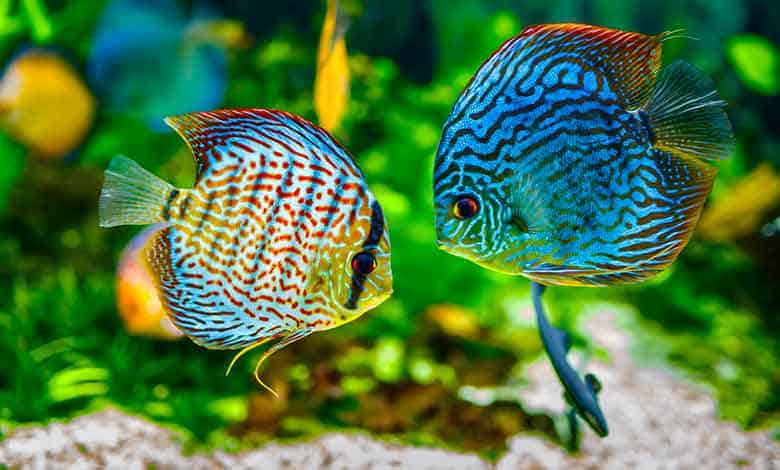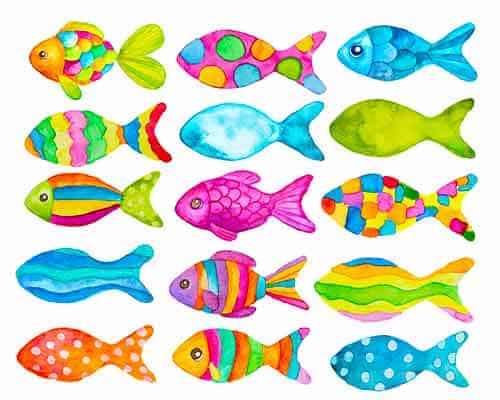
The different factors affect a fish’s color. Six factors affect the fish’s color: lighting, environment, food, age of fish, moods of fish, and then genes. Rainbow fishes are known to be very colorful. Castle can be adjusted depending on the temperature. Environment plays a lot of role in keeping the fish coloration The more natural color the environment is, the more secure the fish would feel. It is because they need to hide from predators.
Why do fish have different colors? (Coloration)
The color of a fish’s flesh isn’t random. It’s based on genetics, file pigments, and even its swimming routine. Tuna, for example, is typically a reddish-pink color. It is because of their extreme endurance.
Their bodies need extra oxygen to feed their muscles. That comes from a protein called myoglobin which stores oxygen in the muscles and acts as a pigment giving them that reddish hue. Many seafood hawkers artificially enhance the color of tuna by exposing it to carbon monoxide gas. It changes it from a gross brown color back into a bright red.
Like the Pacific halibut, fish with light-colored flesh lead far less active lives than their red-blooded counterparts. Most of their time is spent resting on the seafloor. So all of their activity comes in very short bursts. The cooking process causes the proteins in the meat to coagulate, transforming it into a milky white color. That same process occurs in every animal, so raw meat always looks different from cooking.
Salmon are fond of eating krill, and krill are fond of eating algae. The algae eat carotenoids, which give food and plants their bright colors. So when krill eat algae and eat krill, the salmon indirectly consumes those carotenoids, which gives their flesh a bright orange color. But salmon aren’t the only fish that eat krill. So why are they orange and the others aren’t? That is where the genetics part comes in.
Most salmon have a color gene that allows carotenoids to penetrate their muscle tissue. Some salmon, however, lack that gene. So even though they’re identical to the orange. Salmon flesh is a grayish-white color. They’re called ivory kings and sell for a bit more than regular salmon. However, they can be hard to get off the shelves because people are so used to seeing that orange color.

Whitefish has the blue link. Sometimes their flesh will take on a blue color. That’s caused by a bio pigment called Villa Vernon, which gets into the blood serum and turns their flesh into a highly bright shade of blue.
- The majority of fishes are vividly and brightly colored.
- Fishes’ enormous range of colors and patterns are generally related to their environment.
- Normally, darker on the dorsal and lighter on the sides or ventral sides. It gives them protection from above and below.
- Irridocytes can combine with chromatophores to produce reflective colors.
Coloration is one of the most common phenomena found among the fish’s enormous range of colors, and patterns produced in fishes are generally related to their environment.
- When a predator sees from the below side, the fish’s body color resembles the sky’s color and is camouflaged.
- When a predator sees the above side, the body color of the above side fish camouflage with the Seas’ stones.
Fishes have a uniform correlation, as found in the golden fish. There are irridocytes on the surface of the scales. It will have a silvery appearance like that found on the hatchet fish. It is the lower side has irridocytes of the skin. The fish has a white color. The irridocytes sometimes combine with the chromatophores, producing reflective colors. So the important feature is the presence of irridocytes.
The coloration in fish is due to the different pigmentations present in the fish and the color according to the pigment. Fish comes in lots of different colors and patterns.
- Free swimming: Simple coloration, whitish belly, silvery lower sides, back are blue or green.
- Bottom dwellers: Strongly marked above while pale beneath.
- Coral reefs: Most brilliantly and elegantly colored, including Camfinalfishes, butterflyfishes, triggerfishes, and parrotfishes.
- Oceanic: Silver in the upper, red in the middle image, and violet or black in the greater depths.
Their living behavior and their environment decide the coloration of the fish. The pigment present in the body may not be active in the other environment. Mostly the free-swimming fishes have simple coloration. The whitish belly silver lower sires back are blue.
The bottom dweller fishes have strongly marked above white pale beneath. The body’s upper portion is mostly marked with lines, and the belly is pale in color. The fishes present in the coral reefs are mostly brilliantly and elegantly colored.
Oceanic fishes are silver on the upper side. Their middle portion is mainly in the red range, and their depth is violet or black. In-depth, the bottom dweller fishes have strongly marked lines. They have different colors, and their pattern is very rare. It mostly shows the beautiful different color patterns and rainbow colors in these fishes.
Sources of color scales
There are some kinds of sources responsible for color scales.
- Due to schemachromes ( physical configuration) & biochromes true pigments).
- Schemachromes:
White: Skeleton, gas bladder, scales & testes.
Blue & violets: iris.
Iridescent: scales, eyes & intestinal membranes.
- Biochromes includes:
Carotenoids: Yellow, red.
Chromolipoids: Yellow to brown.
Indigoids: Red, blue & green.
Mostly the color scales are only due to the presence of the pigments. Due to the presence of schema Chromes, the physical configuration and Biomes are the true pigments. These are the reasons that the body of the fishes have different color patterns. They are mostly present in white, blue, violet, and indecent colors. The oceanic fishes mostly have silvery colors because purines are present. The Pterins make primarily of white, yellow, red, and orange.
Presence of biochromes
- Carotenoids and purines appear in fish skin Liver, eggs, and eyes have carotenoids.
- Melanin occurs in the endoderm & skin.
- Porphyrins are found in muscle and blood.
- Bile pigments are found in the skeleton and bile.
- Flavins are found in blood, muscle, spleen, gills, heart, kidneys, eggs, liver & eyes.
- Purines are in the scales and eyes, also.
- Pterins are in the eyes, blood, liver, kidneys, and stomach.
These are the pigments that are present in the different organs. Here’s why that organ shows a different color.
Special cell for color
The special cells are specified for the coloration or the pigmentations. Two kinds of cells present the chromatophores and the iridocytes.
Chromatophores: The chromatophores impact true colors. These are located in the skin’s dermis, outside or beneath the scale. These are also found in the peritoneum and deeply around the brain and spinal cord.
The primary type of chromatophores are:
Erythrophores: Red and orange.
Xynthophores: Yellow.
Melanophores: Black.
Leucophores: White.
Iridocytes are mirror cells because they contain reflecting materials that mirror colors outside the fish. It reflects the body of the fish.
Significance of coloration of scales
Different fishes show different colors.
- For communication with either the same species (intraspecific) or different species (interspecific).
- Intraspecific signals for recognition of threat or warning. For sexual purposes and recognition of their parents.
- Interspecific signals for warning or intimidating potential predators.
Functions of coloration of scales
Principal functions of coloration are:
- Concealment.
General color resemblance.
Variable color resemblance.
Obliterative shading.
Disruptive coloration. - Disguise.
- Advertisement.
General color resemblance: It is vital in resemblance b/w fish and its background. E.g., many coral reefs are very bright in colors according to the color of the coral reefs. Some Fishes living over light-shaded bottoms are light-colored, but the same species are dark over dark bottoms.
Variable color resemblance: Fish can gradually change color to match their background gradually or rapidly. Rainbow trout (stream resident phase) is multicolored, including dark spots (young) and rosy sides in adults. The same individuals in the sea are blue above and white below. Variations also occur according to seasons, day or night.
Obliterative shading: It is countershading or Thayer’s law. That is for the darkening and counterweighted.
Disruptive coloration: It is disruptive camouflage or disruptive patterning of irregular patches. It prevents or delays as long as possible recognition on sight.
Many coral reefs are very bright in color. According to the coral colors in the environment, some fishes living over light-shaded bottoms are light-colored, and the same species are dark over dark bottoms. This is the type of concealment. They can change their body color according to their environment, which is the fish’s camouflage type. So the variable color is the fish’s ability to change color to match their environment gradually.
More Articles:
How Do Fish Produce Electricity?
How Does Jellyfish Sting Work?
How Do Sharks Generate Electricity?
References:
“Morphological color changes in fish: Regulation of pigment cell density and morphology.” Microscopy Research and Technique.
The diversity of fishes: biology, evolution, and ecology. Helfman, Gene S., Helfman, Gene S. (2nd ed.).
Endler, John, William C.; Wallace, Bruce (eds.), A Predator’s View of Animal Color Patterns, Evolutionary Biology, Springer US
“Significance of colors and patterns of coral reef fishes: an overview.” ReefCI.
Price, Anna; Weadick, Cameron; Shim, Janet; Rodd, Frieda. “Pigments, Patterns, and Fish Behavior.”
“How fish color their skin: A paradigm for developing and evolving adult patterns.” BioEssays.
Table of Contents
